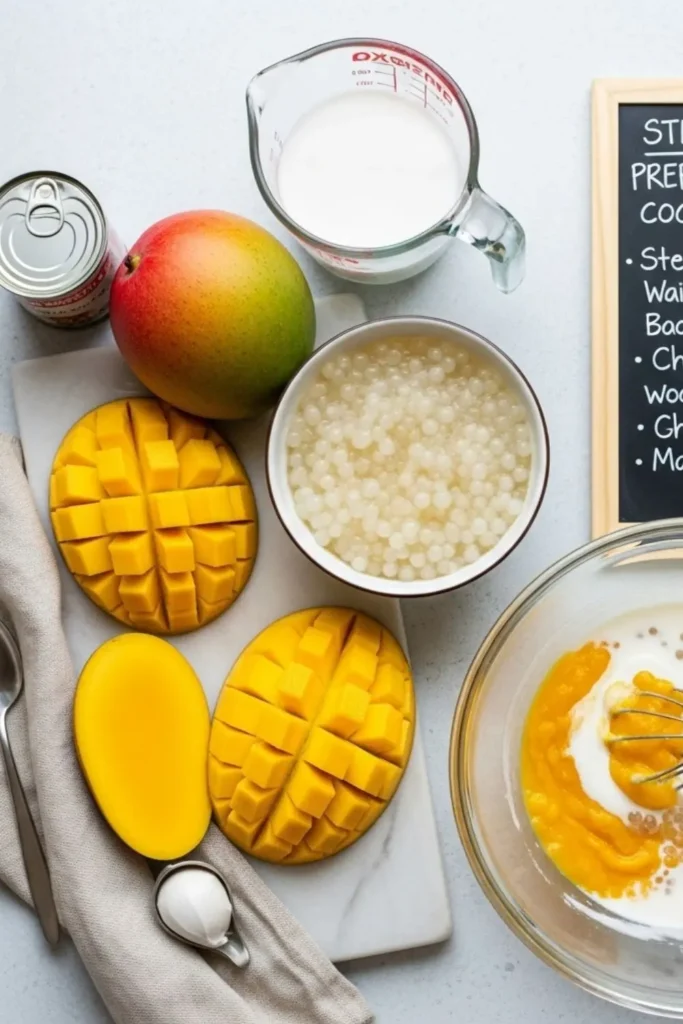Mango Sago is a sweet and creamy Asian dessert made with fresh mango, chewy tapioca pearls (sago), and coconut milk. It serves 4 and takes about 30 minutes to prepare. It’s a popular summer treat in many Southeast Asian countries, especially in Hong Kong, Singapore, and Thailand.
Try More Summer Desserts Recipes:
💛 Why You’ll Love This Mango Sago
- Bursting with tropical mango flavor in every bite: Each spoonful of Mango Sago is packed with sweet, juicy mango. It’s a fruity explosion that feels like a tropical getaway.
- Smooth, creamy, and refreshing—perfect for hot weather: The combination of coconut milk and mango makes this dessert incredibly creamy and cooling, just what you need to beat the heat in summer.
- No baking or complex steps—super easy to make: No oven, no mixer, no stress. This recipe comes together in one bowl with just a blender and a pot for the sago. Anyone can make it!
- Naturally gluten-free and dairy-free: Using tapioca pearls and coconut milk means this dessert is naturally free from gluten and dairy, making it a great choice for those with food sensitivities.
- Great make-ahead dessert that tastes even better chilled: You can prepare this the day before and let it chill overnight. The flavors develop and deepen, and it’s ready to serve when needed.

🥭 Ingredients
- 2 ripe mangoes (peeled and chopped)
- 1/2 cup small tapioca pearls (sago)
- 1 cup coconut milk
- 1/4 cup condensed milk (or to taste)
- 1–2 tbsp sugar (optional, depends on mango sweetness)
- Extra mango cubes for topping
🍹 How To Make Mango Sago
- Cook the sago: Boil 4 cups of water, add tapioca pearls, and cook for 10–15 minutes until mostly translucent. Stir occasionally.
- Rinse & chill: Drain and rinse the sago in cold water. Let it sit in cool water to stop cooking and prevent sticking.
- Blend the mango: Puree the chopped mangoes in a blender until smooth.
- Mix: In a large bowl, combine mango puree, coconut milk, condensed milk, and cooked sago. Adjust sweetness with sugar if needed.
- Chill: Refrigerate for at least 2 hours for best taste.
- Serve: Spoon into bowls or cups, top with extra mango cubes or mint, and enjoy cold.
✅ Recipe Tips
- Always rinse sago well to remove excess starch and prevent clumping.
- For extra richness, use full-fat coconut milk.
- If your mango is not sweet, add more condensed milk or sugar.
- For a twist, add pomelo pulp or a splash of lime juice.
- Blend half of the mango and dice the rest for texture variation.
- Serve in small glasses for a fancy party look.

🥞 What To Serve With Mango Sago?
Serve Mango Sago after light Asian meals like spring rolls or noodle salads. It also pairs well with green tea or jasmine tea add sesame cookies or coconut biscuits on the side for a crunchy contrast to this creamy dessert.
🧊 How To Store Leftovers Mango Sago?
- In the fridge: Store in an airtight container for up to 3 days. Stir before serving as the sago may settle.
- Not recommended for freezing: The texture of the sago and coconut milk can change once frozen and thawed.
❓FAQs
Can I use canned mango for Mango Sago?
Yes, you can use canned mango puree for Mango Sago if fresh mangoes are not available. However, fresh mango gives a brighter flavor and more natural sweetness. If using canned puree, adjust the sugar since it may already be sweetened.
Can I make Mango Sago vegan?
Yes. To make Mango Sago vegan, simply skip the condensed milk and replace it with more coconut milk and a little maple syrup or agave for sweetness. It will still taste rich and creamy without dairy.
Can I make Mango Sago ahead of time?
Yes, Mango Sago is perfect for making ahead. In fact, chilling it for a few hours improves the flavor and texture. Just store it in the fridge and give it a good stir before serving.
Is Mango Sago healthy?
Mango Sago is healthier than many desserts because it uses fresh fruit and can be dairy-free. It’s also naturally gluten-free. To keep it light, reduce or skip the condensed milk and use unsweetened coconut milk.
What kind of mango is best for Mango Sago?
Use sweet, ripe varieties like Ataulfo, Alphonso, or Kent mangoes. These types are naturally juicy, smooth, and less fibrous, which makes them perfect for blending into a creamy base.
Do I need to soak the sago before cooking?
No, small tapioca pearls cook quickly and don’t need soaking. Just boil them directly in water. However, rinse them after cooking to stop the process and remove extra starch.
How can I thicken Mango Sago?
To thicken Mango Sago, reduce the amount of coconut milk or chill it longer. You can also add blended banana or more mango puree for extra thickness.
Try More Summer Desserts Recipes:
🔢 Mango Sago Nutrition Facts (1 serving estimate)
- Calories: 250
- Carbohydrates: 38g
- Protein: 2g
- Fat: 10g
- Fiber: 2g
- Sugar: 20g



